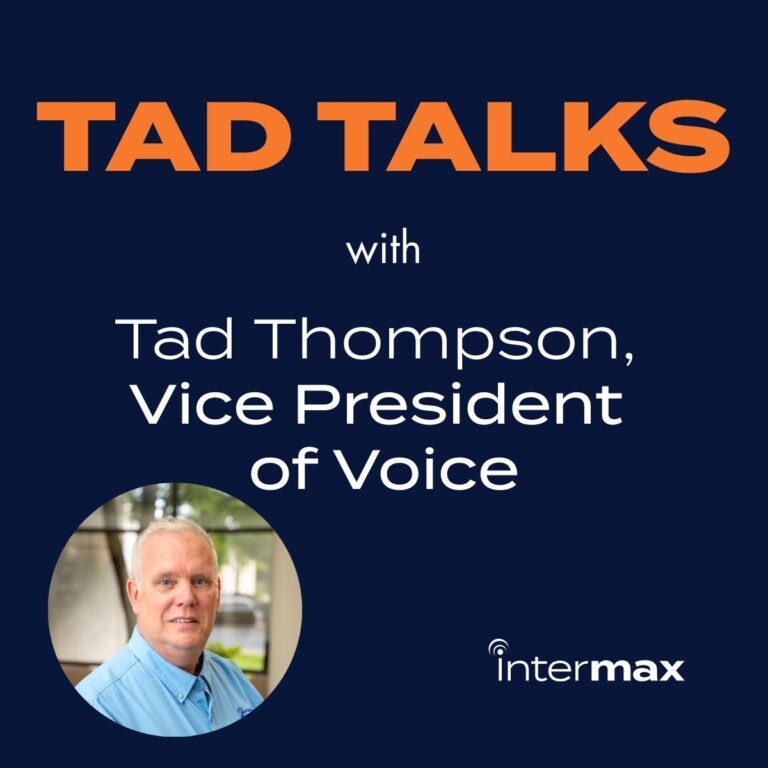
Tad Talk: 40 Years of Dedicated Expertise
In this first installment of Tad Talks, we introduce Tad, Vice President of Voice at Intermax Networks. With 40 years in the telecom industry, Tad has seen it all. His experience brings valuable insight into how business communications have evolved, and why Hosted Voice is changing the game for companies of all sizes. If you’re a business owner, IT leader, or just curious about where telecom is headed, Tad’s perspective is one you’ll want to hear.
Q: What’s your role at Intermax?
A: I’m the Vice President of Voice at Intermax, overseeing the entire Voice department. My team includes field technicians, customer service representatives, technicians, and technician supervisors. We’re a well-structured group with a lot of experience. I try to stay out of the way because these folks are professionals who know what they’re doing. Fortunately, I don’t have to micromanage much.
Q: How did you get started in the telecom industry?
A: I started in the industry when I was 20 years old, wiring telephone and computer systems. Back in those days, phones used massive 25-pair cables. I spent a few years learning the ropes before moving into installation and attending several PBX schools—Mitel, Panasonic, Telrad, and NEC. In those days, you had to be certified by the manufacturer to sell and install their systems.
Eventually, I became a service manager, running and scheduling crews, and then started my own company. I started my own interconnect business selling phone systems and wiring for 14 years. That’s actually how I met Intermax. I sold Intermax an NEC phone system. They had just purchased their softswitch and were getting into the dial tone and hosted phone business. We started working together.
Mike Kennedy, CEO of Intermax, and I had a conversation one day about their NetSapiens soft switch, and we realized the potential of what we could do with it. It was clear that the industry was shifting from traditional PBX systems to VoIP cloud-based systems, and we knew we had to get ahead of that curve to survive. That’s when we merged our companies.
Q: What kind of growth have you seen since joining Intermax?
A: When I joined Intermax, they had maybe 100–200 handsets on the system. Today, we have over 30,000 users on our platform and around 1,200 customers. It’s been a huge leap over the past 12 years. From the old 1A2 key systems, then PBXs, and now VoIP (Voice over Internet Protocol) was the next thing that was going to take over the telecom world.
Q: How has VoIP evolved over the years?
A: Back in the day, voice over IP (VoIP) was a bad word. When it first started out, it was horrible. The quality was terrible—calls broke up constantly because the big internet providers hadn’t optimized their networks for voice. But as the internet improved, so did VoIP. Now, I can take my desk phone anywhere in the world, plug it in, and it works great. No need for dedicated wiring anymore, we just use the customer’s existing network infrastructure. There’s no need to have dedicated telephone wiring or put big boxes in phone rooms anymore. Customers are just blown away. When we installed 400 phones at Saint Martin’s University, they asked, “What equipment are you bringing?” My answer was simple: Just the phones that are going on your desk. That’s all we need with a good Internet connection. That’s the beauty of Hosted Voice. There’s no need for complex infrastructure or bulky equipment.
I remember installing systems that took a week just to mount the hardware. For example, when we transitioned Kootenai County to a Mitel PBX, it took four techs and two months to install everything. Today, setting up Hosted Voice is a fraction of that time. If someone calls and says, “I need a phone turned up,” we can do it the same day. It’s night and day.
Q: How have features evolved in terms of cost and accessibility?
A: Features have also come a long way. Back then, again using Kootenai County as an example, if they wanted call recording, speech recognition, or simultaneous ringing on their desks and cell phones, they needed separate servers for every feature. I installed a system for Kootenai Electric that integrated Mitel and Ericsson. The server cost about $30,000 just to get simultaneous ringing on their cell phone and desk. Today, this capability is a simple checkbox in the portal—and it’s included in our all-inclusive feature set.
Now, with API integrations and custom code, the possibilities are incredible. You can receive a call on your desk phone or your soft-phone, and the caller’s account will pop up in Salesforce based on the caller ID. CRM integrations are getting stronger, and features like PCI redaction for call recording are game-changers. I never imagined this kind of functionality 20 years ago. The industry has changed dramatically in the last 10 years and even more over the past 40. I’m excited to see what the next decade brings.
Looking Back, Moving Forward
Tad’s journey is more than a career story—it’s a front-row seat to the evolution of business communication. From bulky PBX systems to cloud-based Hosted Voice, his experience reflects the innovation and reliability Intermax delivers every day. And this is just the beginning. In future Tad Talks, Tad will share more stories, insights, and practical advice to help businesses stay connected, competitive, and ready for what’s next.
Find Connection with Intermax
Locally owned and operated since 2001, we’re proud to offer high-speed wireless internet, fiber, voice services, and more to thousands of residential and commercial customers.
Headquartered in Coeur d’Alene with offices in Spokane, Seattle, Sandpoint, and St. Maries, the locals’ choice for reliable Business Internet, Hosted Voice, and IT Managed Services for the Inland Pacific Northwest and beyond.
Our friendly North Idaho support team is here to answer any questions you may have. Visit Intermax, or call us at (208) 568-7979, today!





